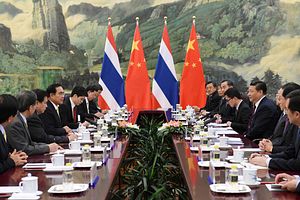On September 4, a steel-cutting ceremony was held in China for the first submarine ordered by Thailand in a landmark, controversial deal that initially made the headlines back in mid-2015. Though the development marks yet another incremental inroad in the China-Thailand submarine deal, it also lays bare the reality that much is left uncertain in terms of the specifics of the purchase and its future outlook.
As I have noted before in these pages, in June 2015, the Royal Thai Navy (RTN) had elected to buy three submarines from China in what would amount to one of the most expensive single acquisitions in the country’s history. Since then, for all the controversy it has generated regarding what this means for Chinese inroads in the region and the future of Thailand’s own alignments as a U.S. treaty ally, the deal itself has been repeatedly delayed, with few details publicly disclosed in the way of specifics.
Following the deal, the RTN had subsequently inked a contract with the China Shipbuilding and Offshore International Corporation (CSOC), the international trading arm of state-owned China Shipbuilding Industry Corporation (CSIC), in May 2017 for one S26T diesel-electric submarine, with the government-to-government contract being worth 13.5 billion baht ($410 million) and the boat set to be delivered by 2023. Orders for another two S26T submarines were expected by 2021 or 2022, with payments to China set to continue until 2027.
Since then, however, there has been little publicly released on the state of the deal and progress with respect to the first submarine. Thai officials have articulated how submarines would factor into the country’s future naval capabilities, but have offered little in terms of follow-up details such as timelines and payment schedules and installments – no small matter given the significant costs involved and political sensitivities this continues to generate domestically in Thailand. Previous suggestions that the initial costs could go up over time had already raised eyebrows among critics and skeptics.
Little has also been said, either from the Chinese or the Thai sides, about the specific capabilities the submarine would have beyond a general understanding that it would be an export variant of China’s Yuan-class submarine and that initial contractual terms had indicated that it would include some weapons systems, spare parts, technology transfer, and other items.
This week, the deal was in focus again with the steel-cutting ceremony for the first submarine. China’s Wuchang Shipbuilding held the ceremony for the first S26T submarine on September 4, with RTN officials in attendance as well.
The ceremony saw both sides hail the significance of the project on its own terms and for wider bilateral ties. For instance, according to Chinese media accounts, RTN Commander-in-Chief Admiral Naris Pratoomsuwan, who attended the ceremony, said he appreciated CSIC’s capabilities and hoped that both sides could use the project as a starting point to deepen wider military-to-military cooperation.
But beyond that, there was little in the way of specifics regarding how this will be advanced into the future. Hu Wenming, the chairman of China Shipbuilding Heavy Industry Group, offered a general commitment that CSIC would ensure that the submarine would be a quality and model project. However, he did not mention any metrics or timelines in that respect.
To be sure, the lack of details is not surprising given the sensitive nature of the purchase, not only internationally but also domestically in Thailand. And for all the delays thus far, there still appears to be continued political will on both sides to at least incrementally advance the project despite lingering concerns.
But for those familiar with Thailand’s decades-long quest for submarines, the lack of specifics such as a timeline and particular capabilities also leaves plenty of room for unexpected developments in the coming years. That is especially the case given the controversy that the submarine purchase itself generates in Thailand as well as the uncertainty still hanging over the junta government’s future and the longer-term transition in Thai domestic politics.
































